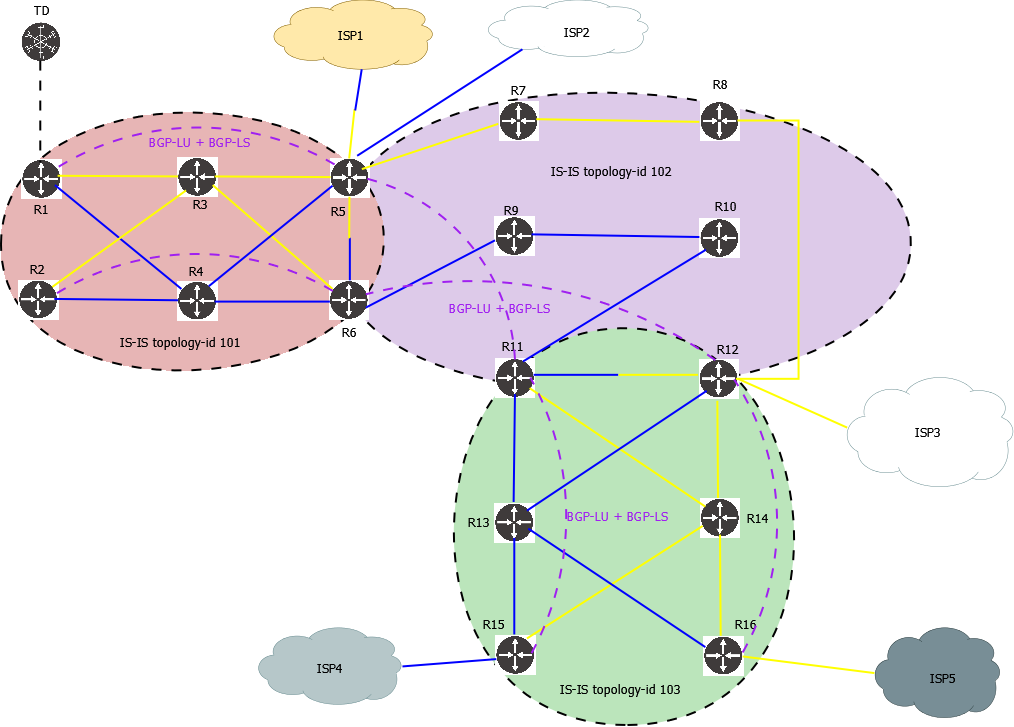Summary
This chapter describes the configuration of SR-TE policies in a multi-domain environment. This includes regular policies (with node endpoint) and EPE policies. EPE-only policies don’t check the IGP topology so they work exactly the same way in single-domain and multi-domain topologies.
In order to calculate TE policies, Traffic Dictator must have a full view of the IGP topology. Therefore:
- TD must receive BGP-LS information about all IGP areas. Which means either TD must have a BGP-LS session with each ABR, or ABRs should be also BGP route reflectors and collect all BGP-LS information from all areas.
- In order to build a multi-domain policy, TD requires explicit path strict or loose to help it find the next ABR. Minimal configuration would just be explicit path loose to ABR loopback.
- When different IGP instances are connected by a BGP link, explicit path strict is required to navigate through the BGP links.
- When calculating TE policies, TD ignores readvertised prefixes and SID with “nophp” flag.
- TD always includes ABR prefix SID in segment list.
Allowed designs
Multi-level IS-IS / Multi-area OSPF
This is the most basic design with only one IGP instance which is split in multiple areas. For example:
In such designs, normally routes from L1/non-zero ara are leaked into L2/area 0 and SID are advertised with “nophp” flag. This allows for IP/MPLS reachability between endpoints even though they don’t have a full view of the IGP topology.
Multiple IGP instances
This is a more common design for large scale ISP, known as Seamless MPLS or Unified MPLS.
Normally there is no redistribution between instances, instead BGP-LU is used to connect across different IGP domains.
Similar considerations to the design with multi-area IGP apply here. In fact this is a recommended design because there is no risk associated with route leaking/redistribution and SPF caching works better here than in multi-area design so the performance on a large topology is better.
Note: TD must receive BGP-LS information from different instances with a different topology-id. If you misconfigure topology-id on routers, this will lead to a mess similar to what you get with duplicate router-id.
Mixing IS-IS and OSPF
This design is fine too. Make sure that IS-IS TE router-ID on ABR nodes is the same as their OSPF router-id.
Mixing IPv4-only and IPv6-only instances
This is also supported. ABRs must support both IPv4 and IPv6. In this topology, an IPv4 policy from topology 101 to topology 103 will first use IPv4 SID to get to the first ABR and then IPv6 SID to get to the second ABR, and then IPv4 again to get to the endpoint.
Connecting IGP domain by BGP links
This is supported too. Can be even multiple BGP links connecting different IGP domains. TD must receive BGP-LS information about IGP topology; BGP Peer SID (or BGP-LU EPE routes), and explicit path strict is required to navigate through the BGP links. The path is still calculated dynamically, TD will check BGP Peer SID and appy path constraints.
Simple multi-domain policy
Consider the following topology:
This is classical Seamless MPLS. 3 IS-IS instances, connected by BGP-LU for end-to-end reachability. Routers connected to the ISP also allocate BGP Peer SID. The existing BGP-LU sessions are also used to distribute BGP-LS and BGP-SRTE routes, so there is no need to setup any additional BGP sessions between TD and different routers.
A simple policy to steer traffic from R1 to R11 using only blue links:
traffic-eng policies
!
policy R1_R11_BLUE_IPV4
headend 1.1.1.1 topology-id 101
endpoint 11.11.11.11 color 100
binding-sid 15003
priority 5 5
install direct srte 192.168.0.101
!
candidate-path preference 100
explicit-path R6_loose_IPV4
metric igp
affinity-set BLUE_ONLY
bandwidth 100 mbps
Explicit path:
traffic-eng explicit-paths
!
explicit-path R6_loose_IPV4
index 10 loose 6.6.6.6
6.6.6.6 is the loopback of R6, which is the ABR (participates in both topologies 101 and 102).
Check the policy:
TD1#show traffic-eng policy R1_R11_BLUE_IPV4 detail
Detailed traffic-eng policy information:
Traffic engineering policy "R1_R11_BLUE_IPV4"
Valid config, Active
Headend 1.1.1.1, topology-id 101, Maximum SID depth: 10
Endpoint 11.11.11.11, color 100
Endpoint type: Node, Topology-id: 102, Protocol: isis, Router-id: 0011.0011.0011.00
Setup priority: 5, Hold priority: 5
Reserved bandwidth bps: 100000000
Install direct, protocol srte, peer 192.168.0.101
Policy index: 5, SR-TE distinguisher: 16777221
Binding-SID: 15003
Candidate paths:
Candidate-path preference 100
Path config valid
Metric: igp
Path-option: explicit
Explicit path name: R6_loose_IPV4
Affinity-set: BLUE_ONLY
Constraint: include-all
List: ['BLUE']
Value: 0x1
This path is currently active
Calculation results:
Aggregate metric: 50
Topologies: ['101', '102']
Segment lists:
[16004, 16006, 16011]
Policy statistics:
Last config update: 2024-09-06 10:26:46,385
Last recalculation: 2024-09-06 10:28:36.836
Policy calculation took 0 miliseconds
This output shows that the policy traverses topologies 101 and 102, also node that SID list includes 16006 which is the R6 SID. TD will always use ABR SID in multi-domain policies.
Explicit path and mixing IPv4/IPv6
Let’s say there is a requirement to steer traffic from R1 to R15 using only blue links but without using affinity, just by using explicit path strict. Also topologies 101 and 103 are IPv4-only and topology 102 is IPv6-only.
Policy config:
traffic-eng policies
!
policy R1_R15_STRICT_MIXED
headend 1.1.1.1 topology-id 101
endpoint 15.15.15.15 color 104
binding-sid 15010
priority 7 7
install direct srte 192.168.0.101
!
candidate-path preference 100
explicit-path R4_R6_R9_R10_R11_R13_strict_MIXED
metric igp
bandwidth 100 mbps
Explicit path:
traffic-eng explicit-paths
!
explicit-path R4_R6_R9_R10_R11_R13_strict_MIXED
index 10 strict 10.100.2.4
index 20 strict 10.100.8.6
index 30 strict 2001:100:13::9
index 40 strict 2001:100:14::10
index 50 strict 2001:100:15::11
index 60 strict 10.100.17.13
Verify the policy:
TD1#show traffic-eng policy R1_R15_STRICT_MIXED detail
Detailed traffic-eng policy information:
Traffic engineering policy "R1_R15_STRICT_MIXED"
Valid config, Active
Headend 1.1.1.1, topology-id 101, Maximum SID depth: 10
Endpoint 15.15.15.15, color 104
Endpoint type: Node, Topology-id: 103, Protocol: isis, Router-id: 0015.0015.0015.00
Setup priority: 7, Hold priority: 7
Reserved bandwidth bps: 100000000
Install direct, protocol srte, peer 192.168.0.101
Policy index: 9, SR-TE distinguisher: 16777225
Binding-SID: 15010
Candidate paths:
Candidate-path preference 100
Path config valid
Metric: igp
Path-option: explicit
Explicit path name: R4_R6_R9_R10_R11_R13_strict_MIXED
Affinity-set: BLUE_ONLY
Constraint: include-all
List: ['BLUE']
Value: 0x1
This path is currently active
Calculation results:
Aggregate metric: 70
Topologies: ['101', '102', '103']
Segment lists:
[16004, 16006, 17011, 16013, 16015]
Policy statistics:
Last config update: 2024-09-06 10:26:46,385
Last recalculation: 2024-09-06 10:28:36.840
Policy calculation took 0 miliseconds
Note that TD does not use each SID from explicit path. It just uses SID that are required to steer traffic via the specified path, + ABR SID to connect different IGP domains.
Anycast SID for ABR
In real world design, this topology makes the most sense if the pairs of ABR announce an anycast SID. Let’s say R5-R6 announce prefix 56.56.56.56/32 and 2002::56/128; R11-R12 announce SID prefix 11.11.12.12/32 and 2002::1112/128.
As in the previous example, topologies 101 and 103 are IPv4-only and topology 102 is IPv6-only. In order to connect these 3 IGP instances using anycast SID and also use ECMP, configure the following policy:
traffic-eng policies
!
policy R1_R16_LOOSE_ANYCAST_MIXED
headend 1.1.1.1 topology-id 101
endpoint 16.16.16.16 color 112
binding-sid 15013
priority 7 7
install direct srte 192.168.0.101
!
candidate-path preference 100
explicit-path ANYCAST_MIXED
metric igp
bandwidth 100 mbps
Explicit path:
traffic-eng explicit-paths
!
explicit-path ANYCAST_MIXED
index 10 loose 56.56.56.56
index 20 loose 2002::1112
Verify the policy:
TD1#show traffic-eng policy R1_R16_LOOSE_ANYCAST_MIXED detail
Detailed traffic-eng policy information:
Traffic engineering policy "R1_R16_LOOSE_ANYCAST_MIXED"
Valid config, Active
Headend 1.1.1.1, topology-id 101, Maximum SID depth: 10
Endpoint 16.16.16.16, color 112
Endpoint type: Node, Topology-id: 103, Protocol: isis, Router-id: 0016.0016.0016.00
Setup priority: 7, Hold priority: 7
Reserved bandwidth bps: 100000000
Install direct, protocol srte, peer 192.168.0.101
Policy index: 12, SR-TE distinguisher: 16777228
Binding-SID: 15013
Candidate paths:
Candidate-path preference 100
Path config valid
Metric: igp
Path-option: explicit
Explicit path name: ANYCAST_MIXED
This path is currently active
Calculation results:
Aggregate metric: 70
Topologies: ['101', '102', '103']
Segment lists:
[16056, 17112, 16016]
Policy statistics:
Last config update: 2024-09-06 10:26:46,386
Last recalculation: 2024-09-06 10:28:36.842
Policy calculation took 1 miliseconds
Note how the policy uses the respective IPv4 and IPv6 anycast SID, thus achieving ECMP load sharing with only one segment list.
EPE and Null-endpoint policies
You can configure EPE policies in a multi-domain environment the same way as regular policies. One caveat pertains Null-endpoint policies: if you want the null-endpoint policy to route to a different topology, the local topology MUST NOT have any egress peer matching the constraints. If there is a suitable egress peer in the local topology, TD will try to build the path to this peer, and your explicit path is likely to fail if it points to another topology.
Bandwidth reservations
Bandwidth reservations work exactly the same as with regular policies. Check reserved bandwidth using “show topology id <>” command:
TD1#show topology id 101
---
ISIS links
0004.0004.0004.00 [E][L2][I101][N[c65002][b0][s0004.0004.0004.00]][R[c65002][b0][s0006.0006.0006.00]][L[i10.100.8.4][n10.100.8.6][i2001:100:8::4][n2001:100:8::6]]
IGP metric: 10
TE metric: 500
Affinity: 0x1
Max-bw: 10000000000
Unrsv-bw priority 0: 10000000000
Unrsv-bw priority 1: 10000000000
Unrsv-bw priority 2: 10000000000
Unrsv-bw priority 3: 10000000000
Unrsv-bw priority 4: 10000000000
Unrsv-bw priority 5: 9800000000
Unrsv-bw priority 6: 9800000000
Unrsv-bw priority 7: 9000000000
Policies priority 0: []
Policies priority 1: []
Policies priority 2: []
Policies priority 3: []
Policies priority 4: []
Policies priority 5: ['R1_R11_BLUE_IPV6', 'R1_R11_BLUE_IPV4']
Policies priority 6: []
Policies priority 7: ['R1_R15_STRICT_IPV4', 'R1_R16_LOOSE_ANYCAST_IPV6', 'R1_R16_LOOSE_ANYCAST_IPV4', '5 more policies']
TD1#show topology id 102
Topology information
---
ISIS links
0008.0008.0008.00 [E][L2][I102][N[c65002][b0][s0008.0008.0008.00]][R[c65002][b0][s0012.0012.0012.00]][L[i10.100.12.8][n10.100.12.12][i2001:100:12::8][n2001:100:12::12]]
IGP metric: 10
TE metric: 500
Affinity: 0x2
Max-bw: 10000000000
Unrsv-bw priority 0: 10000000000
Unrsv-bw priority 1: 10000000000
Unrsv-bw priority 2: 10000000000
Unrsv-bw priority 3: 10000000000
Unrsv-bw priority 4: 10000000000
Unrsv-bw priority 5: 10000000000
Unrsv-bw priority 6: 10000000000
Unrsv-bw priority 7: 9400000000
Policies priority 0: []
Policies priority 1: []
Policies priority 2: []
Policies priority 3: []
Policies priority 4: []
Policies priority 5: []
Policies priority 6: []
Policies priority 7: ['R1_ISP3_YELLOW_IPV6_MIXED', 'R1_R16_LOOSE_ANYCAST_IPV6', 'R1_R16_LOOSE_ANYCAST_IPV4', '3 more policies']







